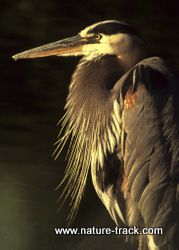Plumes Transform Herons and Egret Males into Living Art

©Terry R. Thomas/www.nature-track.com
Great blue herons and others of the same family were nearly hunted to extinction to satisfy the demands of ladies’ fashion in the late 1800’s. Conservation finally carried the day though and populations rebounded under protection.
The long thin plumes of the male great blue heron flutter in the breeze like a gray pirate's beard.
He is wary of me as he searches for breakfast, but he is more than a little interested in the female nearby. The plumes, growing on his chest and head, are specifically to woo her into being his mate, and he wants to make sure she can fully appreciate them.
In a world where function trumps form, this seems like an anomaly. Unlike wing and tail feathers, these plumes, aigrettes as they are called, don't aid in flight and don't keep him warm. They are strictly for show and in the heron's world they may be the most important feathers on his body. If he cannot attract a mate, he does not breed. If he does not pass his genes on to the next generation, then ecologically he is a failure.
Aigrette is a French word meaning 'egret.' These useless yet essential feathers are the trademark of the egrets as well as herons. Egrets and herons are always beautiful, but with subtle lines and regal poses, unlike the audacious colors of a golden pheasant or the flamboyant birds of paradise.
As the aigrettes grow in the spring, however, their beauty embraces elegance. When a male egret displays, he is no longer a bird, but a breathtaking work of living art that stirs the human heart. Birds with aigrettes are so stunning, so inspiring, that for a time, this was nearly their undoing.
In the late 1800s, women craved these feathers, using them to adorn their hats and augment their beauty and status. Egrets and herons were attached to the feathers, literally and figuratively, and giving them up meant over their dead bodies. The dead bodies piled up quickly to satisfy fashion.
With an ounce of aigrettes selling for twice the price of an ounce of gold in 1886, market hunters swarmed to the wetlands that egrets and herons call home. With traps and guns, they harvested as if the birds were a gold mine to be played out.
At the peak of the carnage, the New York Ornithological Society estimated that five million birds were harvested annually. Great egret populations careened downward until just five percent clung to survival.
The slaughter fanned conservation flames and citizens decried the decimation. By the time laws were finally passed to outlaw trade in wildlife, a wildlife refuge system had been born, two of its first four game wardens had been murdered and a brand new conservation organization, The Audubon Society, had been formed.
Two things saved the egrets and the herons: People who cared more about the birds than a fleeting financial balance sheet and the enforcement of laws that protected a public resource. One hundred years later, heron and egret populations have rebounded from their tango with extinction and all are thriving for us to enjoy.
These egrets and herons, with their amazing aigrettes, are now a reminder that beauty sometimes comes at a price and being homely is sometimes a great advantage!
Goodreads Book Giveaway
The Best of Nature
by Terry R. Thomas
Giveaway ends June 24, 2014.
See the giveaway details at Goodreads.

"WOW. What a phenomenal piece you wrote. You are amazing." Jennifer Jackson
That is embarrassing, but actually a fairly typical response to my nature essays. Since The Best of Nature is created from the very best of 16 years of these nature essays published weekly in the Idaho Falls Post Register (online readership 70,000), it is a fine read. It covers a wide variety of topics including humorous glimpses of nature, philosophy, natural history, and conservation. Readers praise the style, breadth of subject matter and my ability to communicate complex and emotional topics in a relaxed and understandable manner.
Everyone can find something to love in this book. From teenagers to octogenarians, from the coffee shop to the school room, these nature essays are widely read and enjoyed.
Some of the essays here are my personal favorites, others seemed to strike a chord with readers. Most have an important message or lesson that will resonate with you. They are written with a goal to simultaneously entertain and educate about the wonderful workings of nature. Some will make you laugh out loud and others will bring a tear to the eye and warm your heart.
Readers Write:
"You hit a home run with your article on, Big Questions in Nature. It should be required reading for everyone who has lost touch with nature...great job!" Joe Chapman
"We enjoyed your column, Bloom Where Planted. Some of the best writing yet. The Post Register is fortunate to have your weekly columns." Lou Griffin.
To read more and to order a copy, click here or get the Kindle version
Copies are also available at:
Post Register
Island Park Builders Supply (upstairs)
Barnes and Noble in Idaho Falls
Harriman State Park, Island Park
Museum of Idaho
Valley Books, Jackson Wyoming
Avocet Corner Bookstore, Bear River National Wildlife Refuge, Brigham City, Utah
Craters of the Moon National Monument Bookstore, Arco, Idaho
